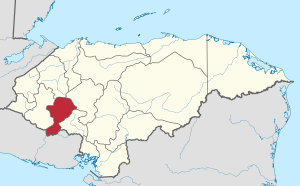Intibucá Department facts for kids
Quick facts for kids
Intibucá Department
Departamento de Intibucá
|
||
|---|---|---|
|
department
|
||
|
||

Location of Intibucá in Honduras
|
||
| Country | ||
| Municipalities | 17 | |
| Villages | 126 | |
| Founded | 16 Abril 1883 | |
| Capital city | La Esperanza | |
| Government | ||
| • Type | Departmental | |
| Area | ||
| • Total | 3,126 km2 (1,207 sq mi) | |
| Area rank | 14th | |
| Population
(2015)
|
||
| • Total | 241,568 | |
| • Rank | 13th | |
| • Density | 77.277/km2 (200.15/sq mi) | |
| Time zone | UTC-6 (CDT) | |
| Postal code |
14000, 14101, 14201
|
|
| ISO 3166 code | HN-IN | |
| HDI (2017) | 0.538 low · 16th |
|
| Statistics derived from Consult INE online database: Population and Housing Census 2013 | ||
Intibucá (pronounced inti-BOO-kah) is one of the 18 departments in the country of Honduras. It covers a total area of about 3,126 square kilometers (1,186 square miles). The capital city of Intibucá is La Esperanza.
Contents
History of Intibucá
The department of Intibucá was officially created on April 16, 1883. Before this, it was part of a much larger department called Gracias.
In 1869, the Governor of Gracias, Jose Maria Cacho, suggested that the department was too big to manage easily. He thought it would be better to divide it into smaller parts.
So, on March 7, 1883, a special rule (Decree No. 10) was made. This rule called for a new department named Intibucá to be created in April of that year. The town of La Esperanza was chosen to be the capital of this new department. To form Intibucá, land was taken from both the Gracias department and the La Paz department.
Geography and Landscape
The department of Intibucá is located in Honduras. It shares borders with several other departments. To the north, it borders Comayagua, Lempira, and Santa Bárbara. To the east, it borders Comayagua and La Paz. Lempira is to its west, and the country of Republic of El Salvador is to its south.
Intibucá is known for being the most mountainous area in Honduras. The capital city, La Esperanza, is very high up, about 1,509 meters (4,950 feet) above sea level. The flat areas and valleys are also higher than in most other parts of Honduras. Some mountain ranges here reach almost 3,048 meters (10,000 feet) high.
The Otoro valley is a large flat area, about 30 kilometers (18.6 miles) long and 8 kilometers (5 miles) wide. The Opalaca mountains have many ridges and extend into the La Paz department. The Sierra de Montecillos mountains form a natural border with the Comayagua department. This range includes mountains like Opatoro, Concepción, and El Picacho.
Rivers of Intibucá
Several rivers flow through Intibucá. The San Juan River and the Intibucá River both pass through La Esperanza. The Otoro River flows into the Ulua River and carries water to the Otoro valley.
The Black River, also known as the Guarajambala River, forms a border with the Lempira department. The Torola River and Gualcarque River both flow into the larger Lempa river.
Population Growth
In 1895, a count of the people showed that Intibucá had 18,957 residents. By 2015, the population had grown a lot, reaching 241,568 people.
This population is spread across 17 different municipalities and 126 smaller villages, called aldeas.
Natural Resources
The mountains and slopes of Intibucá are rich in forests. You can find many pine and oak trees growing there. The valleys have very fertile soil, meaning it's good for growing plants. This soil is also well-watered. The plants found here are typical of cooler, temperate areas rather than very hot tropical zones.
Municipalities of Intibucá
Intibucá is divided into the following local areas, called municipalities:
- Camasca
- Colomoncagua
- Concepción
- Dolores
- Intibucá
- Jesús de Otoro
- La Esperanza
- Magdalena
- Masaguara
- San Antonio
- San Francisco de Opalaca
- San Isidro
- San Juan
- San Marco de Sierra
- San Miguel Guancapla
- Santa Lucía
- Yamaranguila
Notable People from Intibucá
Many important people have come from Intibucá, including:
- General Vicente Tosta Carrasco: He was the President of Honduras from 1924 to 1925.
- Doctor Vicente Mejía Colindres: He served as the Constitutional President of the Republic from 1929 to 1933.
- General Gregorio Ferrera: A military officer, politician, and important leader in Honduras.
- Rafael Manzanares Aguilar: A Honduran folklorist, author, and music composer. He started and was the first director of the National Office of Folklore of Honduras. He also founded and directed the Cuadro de Danzas Folklóricas de Honduras, a folk dance group.
- Rafael Pineda Ponce: A politician and educator, born in San Miguelito.
- Natanael del Cid Menedez: A politician and rancher who helped shape the country's laws.
See also
 In Spanish: Departamento de Intibucá para niños
In Spanish: Departamento de Intibucá para niños

